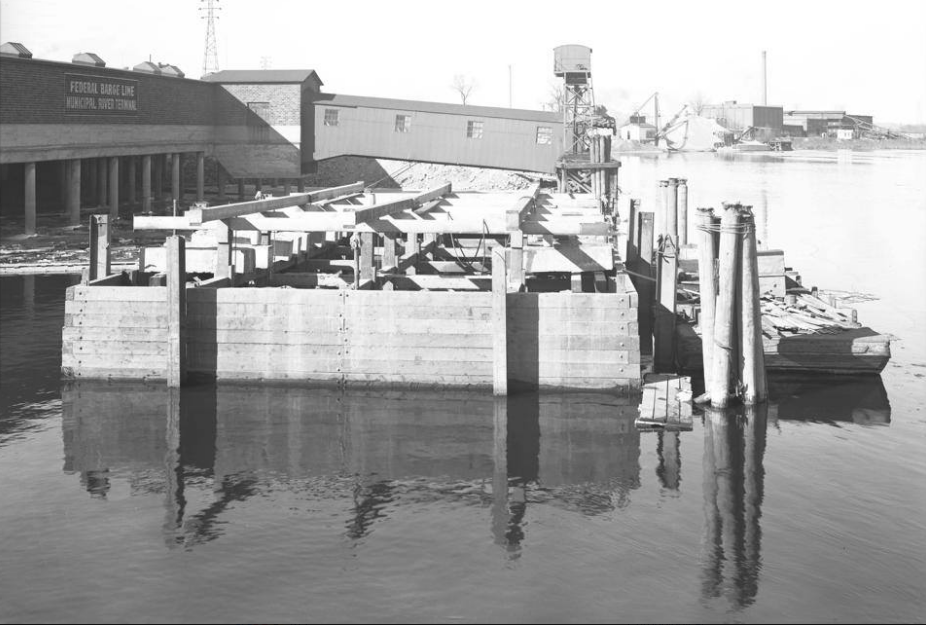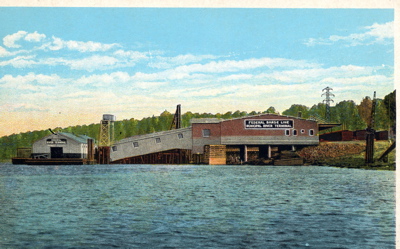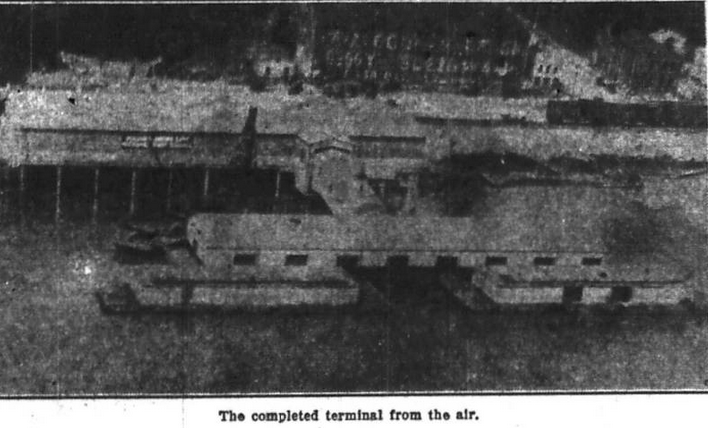Encyclopedia Dubuque
"Encyclopedia Dubuque is the online authority for all things Dubuque, written by the people who know the city best.”
Marshall Cohen—researcher and producer, CNN
Affiliated with the Local History Network of the State Historical Society of Iowa, and the Iowa Museum Association.
FEDERAL BARGE LINE: Difference between revisions
No edit summary |
No edit summary |
||
| Line 1: | Line 1: | ||
[[Image:imp356.jpg|left|thumb|350px|Photo courtesy: Bob Reding]] | [[Image:imp356.jpg|left|thumb|350px|Photo courtesy: Bob Reding]] | ||
FEDERAL BARGE LINE. Barges are used for bulk items since the cost of hauling goods by barge is very low. Barges are also used for very heavy or bulky items. A typical barge measures 195 by 35 feet (59.4 m × 10.6 m), and can carry up to 1,500 tons of cargo. Extremely large objects are normally shipped in sections and assembled on site, but shipping an assembled unit | FEDERAL BARGE LINE. Barges are used for bulk items since the cost of hauling goods by barge is very low. Barges are also used for very heavy or bulky items. A typical barge measures 195 by 35 feet (59.4 m × 10.6 m), and can carry up to 1,500 tons of cargo. Extremely large objects are normally shipped in sections and assembled on site, but shipping an assembled unit reduces costs and avoids reliance on construction labor at the delivery site. Self-propelled barges may be used when traveling downstream or upstream in placid waters. They are operated as an unpowered barge, with the assistance of a tugboat when traveling upstream in faster waters. | ||
During [[WORLD WAR I]], the federal government realized that while railroads were having great difficulty in moving | During [[WORLD WAR I]], the federal government realized that while railroads were having great difficulty in moving large volumes of traffic, the river systems were not being utilized. | ||
In 1922 the announcement was made that barge line operation between Minneapolis and St. Louis was in the near future. W. P. Trickett, vice-president of the combined Upper Mississippi Waterways and the Mississippi Valley associations remarked that development of the upper [[MISSISSIPPI RIVER]] was also part of the government program. At the present time, the government | In 1922 the announcement was made that barge line operation between Minneapolis and St. Louis was in the near future. W. P. Trickett, vice-president of the combined Upper Mississippi Waterways and the Mississippi Valley associations remarked that development of the upper [[MISSISSIPPI RIVER]] was also part of the government program. At the present time, the government operated a barge line between St. Louis and the Gulf of Mexico. With the completion of the line to Minneapolis, increased river traffic was expected. Trickett announced plans for a conference of city representatives along the upper river for outlining a campaign and increasing association membership. While the entire state of Iowa was expected to enjoy benefits of this improvement in river traffic, cities along the river were expected to see the most. (1) | ||
The Transportation Act of 1920 passed by Congress established the Inland Waterways Corporation in 1924. The Act required freight to be balanced and in bulk. The government would continue in the operations long enough to demonstrate water transportation possibilities and attract private enterprise. (2) The Federal Barge Line operating between St. Louis and New Orleans was coordinated with the railroad lines through the Interstate Commerce Commission which established through rates that divided the revenue between the barge line and the railroads. As soon as it opened, the Federal Barge Line had more to carry than it could handle. 85% of the freight carried was partially rail freight. The barge line served thirty-six states and had business with 165 railroads. (3) | The Transportation Act of 1920 passed by Congress established the Inland Waterways Corporation in 1924. The Act required freight to be balanced and in bulk. The government would continue in the operations long enough to demonstrate water transportation possibilities and attract private enterprise. (2) The Federal Barge Line operating between St. Louis and New Orleans was coordinated with the railroad lines through the Interstate Commerce Commission which established through rates that divided the revenue between the barge line and the railroads. As soon as it opened, the Federal Barge Line had more to carry than it could handle. 85% of the freight carried was partially rail freight. The barge line served thirty-six states and had business with 165 railroads. (3) | ||
Latest revision as of 20:23, 28 July 2025
FEDERAL BARGE LINE. Barges are used for bulk items since the cost of hauling goods by barge is very low. Barges are also used for very heavy or bulky items. A typical barge measures 195 by 35 feet (59.4 m × 10.6 m), and can carry up to 1,500 tons of cargo. Extremely large objects are normally shipped in sections and assembled on site, but shipping an assembled unit reduces costs and avoids reliance on construction labor at the delivery site. Self-propelled barges may be used when traveling downstream or upstream in placid waters. They are operated as an unpowered barge, with the assistance of a tugboat when traveling upstream in faster waters.
During WORLD WAR I, the federal government realized that while railroads were having great difficulty in moving large volumes of traffic, the river systems were not being utilized.
In 1922 the announcement was made that barge line operation between Minneapolis and St. Louis was in the near future. W. P. Trickett, vice-president of the combined Upper Mississippi Waterways and the Mississippi Valley associations remarked that development of the upper MISSISSIPPI RIVER was also part of the government program. At the present time, the government operated a barge line between St. Louis and the Gulf of Mexico. With the completion of the line to Minneapolis, increased river traffic was expected. Trickett announced plans for a conference of city representatives along the upper river for outlining a campaign and increasing association membership. While the entire state of Iowa was expected to enjoy benefits of this improvement in river traffic, cities along the river were expected to see the most. (1)
The Transportation Act of 1920 passed by Congress established the Inland Waterways Corporation in 1924. The Act required freight to be balanced and in bulk. The government would continue in the operations long enough to demonstrate water transportation possibilities and attract private enterprise. (2) The Federal Barge Line operating between St. Louis and New Orleans was coordinated with the railroad lines through the Interstate Commerce Commission which established through rates that divided the revenue between the barge line and the railroads. As soon as it opened, the Federal Barge Line had more to carry than it could handle. 85% of the freight carried was partially rail freight. The barge line served thirty-six states and had business with 165 railroads. (3)
As soon as navigation was possible in the spring of 1926, General T.Q. Asburn of the Federal Barge Line ordered a visit to Pittsburgh, Pennsylvania to determine what type of towboat and barge should be constructed. (4) He then ordered a survey of communities along the Mississippi. (5) This ocurred on October 13, 1926, when W.W. Morse, vice president and general manager of the Upper Mississippi Barge Line headquartered in Minneapolis, Minnesota, met with members of the Dubuque Chamber of Commerce. Morse explained that shippers in Minneapolis and St. Paul were interested in river traffic. Between 1920 and 1926, the cost of rail car lot shipments had increased 200 percent in some instances. The Minneapolis businessmen believed the use of the river would free the area from the freight rates handicapping agriculture, manufacturing and business. (6)
Conditions were studied and then it was decided to form a corporation, the UPPER MISSISSIPPI BARGE LINE COMPANY, to construct and operate a barge line on the upper MISSISSIPPI RIVER. Minneapolis contributed $72,000, St. Paul $48,000, Dubuque $5,000 with other cities along the river contributing various amounts. Finally a contract was written with the federal government's Inland Waterways Corporation. The DUBUQUE BOAT AND BOILER WORKS received the contract to build three tow boats. (7)
Morse went on to suggest that Dubuque was the logical terminal as a transfer point for shipments going to and from Chicago and the Twin Cities and that a great amount of rail and water traffic for shippers from the area west of Dubuque would be routed by way of the city. The problem in Dubuque was that the government required a satisfactory terminal. Dubuque had no dock or loading ramp for barges and problems at the levee made unloading difficult. (8)
On October 14, 1926, the Dubuque City Council took official action authorizing a special city election on the the day of the general election that year, November 2, on the following question:
Shall the city council of the City of Dubuque
be authorized to create a department to be known
as the department of public docks?
The city council also authorized representatives of the city to accompany representatives of the Chamber of Commerce, DUBUQUE SHIPPERS' ASSOCIATION and the press on a trip of the lower Mississippi River to inspect terminals and barge line activities in St. Louis and New Orleans. This tour began on October 16, 1926. (9)
The members of the touring committee found various terminals along the river busy with commerce--more than the communities had before the terminals. The terminals had been constructed and then leased to the barge line. Flat fees per ton of freight handled, generally twenty percent lower than all-rail charges, were enough after one year to cover fixed costs and establish a reserve fund. The barge traffic had also led to significant employment increase in the affected communities. (10)
Th election results showed support for the proposal in every one of the fifteen precincts. The total vote was 6,732 to 2,970. The city council named John A. KERPER and P.S. Fawkes, two of the people who had participated in the tour, and Louis Brede, a former city commissioner, to the first dock commission. This commission determined the kind of terminal to be erected and directed the work at SOUTH PORT to completion. C.J. Hoffman and L.E. Moore were the first terminal superintendent and chief clerk respectively. (11)
When the terminal was completed in 1930 from two to six barges could be unloaded at one time. Two tow motors, hauling from one to five five of the 30 two-ton loading and unloading trucks were used for the lighter loads. Heavier freight was moved by an eighteen-ton crane and a specially designed runway south of the terminal. (12)
One of the new industries mentioned by the commission in 1926 was commented on by barge line officials in 1935. It was their hope that a drydock would be finished in the harbor by 1936 for the use of the company and other craft in reconditioning boats for the following season. During 1935, employment averaged between 20-25 with as high as 75 laborers working a four-day week. (13)
In 1936 President Franklin Roosevelt wanted to change the idea that the corporation which owned the barge line would ever be sold. He had the business transferred from the War Department to the Commerce Department despite criticism. (14)

Federal Barge Line terminal near construction of the JULIEN DUBUQUE BRIDGE. ]]To protect construction sites from enemy attack during WORLD WAR II, ship manufacturers were relocated far from the Pacific Coast along the Columbia River. Another site was located along the Mississippi River. In 1943 the Agawam at 3,500 tons the largest boat ever to travel the Mississippi to that date docked at the Federal Barge Line terminal on its way to New Orleans. Manufactured in Savage, Minnesota, the navy tanker would be used as a supply vessel to transport fuel oil and gasoline. The Agawam was one of six tankers to be manufactured at the Savage plant. (15)
Lack of funds and the need for modern equipment led President Harry S. Truman to ask Congress for a $3 million dollars increase in the capital stock for the barge line in 1950. At the time, legislation was pending in Congress to increase the capital stock of the corporation from $15 million to $33 million. Barge line officials and the Secretary of Commerce, however, said the corporation could be modernized and put on a paying basis for $10 million. At that time, the barge line was the only less than carload barge service available to small shippers. Small shippers wanted it to be continued, while railroads and eastern ports wanted it closed. (16)
The appropriation did not get passed. In 1953 the Secretary of Commerce was making a new attempt to sell the Inland Waterways Corporation. The corporation which owned the Federal Barge Line lost $325,000 in 1952 and between 1924 and 1948 ran a deficit of $5.5 million. In 1953 there were more than one hundred companies competing with it for business. (17)
In 1953 Herman T. Pott purchased the Federal Barge Lines from the government, and built the M.V. America and the M.V. United States, the two most powerful towboats in the world. Mr. Pott expanded the company under the name St. Louis Shipbuilding - Federal Barge Lines, Inc. In 1967, Mr. Pott changed the company's name to Pott Industries, Inc. (18)
Accidents involving barges, although rare, have occurred. On June 9, 2008 fifteen fully loaded barges struck the JULIEN DUBUQUE BRIDGE. Ten of the barges were full of corn, four with soybeans, and one with iron ore. The bridge was closed to traffic until June 10th when Iowa Department of Transportation officials inspected the bridge and found no serious damage to the structure. On May 4, 2018 perhaps the greatest threat to the lock and dam occurred. In the afternoon, a group of twelve barges broke apart from the towboat and struck the dam. One of the barges went over the dam on Saturday morning while two others filled with corn and beans sank above the dam. Damage to the dam was not known four days later. The announcement was made that efforts to raise the sunken barges would not be made until the water level dropped. (19)
See: MISSISSIPPI RIVER PORTS OF EASTERN IOWA AND WESTERN ILLINOIS
---
Source:
1. "Barge Line for Upper River, Plan," Dubuque Telegraph-Herald, March 6, 1922, p. 8
2. Kruse, Len. "The Federal Barge Line," My Old Dubuque. Center for Dubuque History, Loras College, Dubuque, Iowa 2000 p. 232-236
3. "Madden Exposes His Hand," Telegraph Herald, January 29, 1926, p. 6
4. Ibid.
5. Ibid.
6. Kruse
7. Ibid.
8. Ibid.
9. Ibid.
10. "Committee Reports on Trip to Southern River Cities," Telegraph Herald, October 29, 1926, p. 2
11. Ibid.
12. Ibid.
13. "1935 Season to End in Six Weeks," Telegraph Herald, October 29, 1935, p. 25
14. "Government Waterways," Telegraph Herald, March 27, 1953, p. 3
15. "Tanker Bound for Sea Duty," Telegraph Herald, November 10, 1943, p. 11
16. "Barge Line Funds Asked by Truman," Telegraph Herald, January 9, 1950, p. 14
17. "Government Waterways..."
18. The Pott Foundation. Online: http://www.pottfoundation.org/herman-pott-phenie-pott.htm
19. "2 Sunken Barges Remain After Pileup at Lock and Dam No. 11," Telegraph Herald, May 8, 2018, p. 3A



